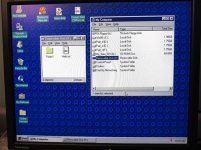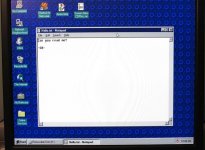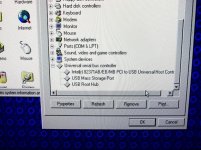clh333
Veteran Member
This is a board that came from an HP Pavilion system, has PII CPU and Intel 440BX chipset, 760 Mb memory. Has 2 ISA and 4 PCI slots. Installed Win95 4.00.950 C from CD and started addressing the missing drivers.
The board has an on-board ATI Rage chip but it was fuzzy and Win95 could not do more than VGA with it so I inserted a PCI Diamond Stealth 3D 2000 PCI card and installed their driver. Sharper, faster and higher bit depth (800x600, 16M). Device manager still lists the ATI as Standard VGA Adapter, with an exclamation point (!), as well but for now that does not seem to present a problem since nothing is attached to it. There does not seem to be a way to disable it in BIOS. (PhoenixBIOS 4.0 Release 6.0.B.)
Win95 did not install a USB driver by default but I found and installed one from the CD distro. Ran USBSUPP.EXE to install drivers; now each bootup I am prompted "Found New Hardware, PCI Universal Serial Bus". For now I cancel and the desktop loads, as I have no idea what to use as a driver.
Device manager also lists with a question mark (?) "Other Devices", under which are "PCI Bridge" and Unknown Device", whose parent is "Standard Dual PCI IDE Controller". DM will not let me remove the Other Device so I ignore that. Found New Hardware no longer tries to install the PCI bridge as it did the first several times I booted. No other problems noted in DM, but DM does not list a USB hub, either.
Did some research and found that this behavior is often exhibited in Win95 installations and has to do with Win95 not recognizing the Intel 440X chipset. Mine has a 440BX chipset, according to ASUS who manufactured the board (ASUS P2B98-XV stamped on the board).
I found the Intel Chipset driver installation utility INFINST_ENU.EXE and tried to run it under Win95 (won't run from DOS). The self-extracting utility extracts files and launches the installer, which gets as far as the license screen. I accept the terms of the license and installation hangs there. When I cancel out of the installation a dialog tells me a remote procedure call failed.
I'd like to solve this problem but I'm stuck as to what to do next. I could wipe the disk and start over, but I'm not sure what good that would do me.
If anyone has any suggestions I would welcome your input. Thanks for your replies.
-CH-
The board has an on-board ATI Rage chip but it was fuzzy and Win95 could not do more than VGA with it so I inserted a PCI Diamond Stealth 3D 2000 PCI card and installed their driver. Sharper, faster and higher bit depth (800x600, 16M). Device manager still lists the ATI as Standard VGA Adapter, with an exclamation point (!), as well but for now that does not seem to present a problem since nothing is attached to it. There does not seem to be a way to disable it in BIOS. (PhoenixBIOS 4.0 Release 6.0.B.)
Win95 did not install a USB driver by default but I found and installed one from the CD distro. Ran USBSUPP.EXE to install drivers; now each bootup I am prompted "Found New Hardware, PCI Universal Serial Bus". For now I cancel and the desktop loads, as I have no idea what to use as a driver.
Device manager also lists with a question mark (?) "Other Devices", under which are "PCI Bridge" and Unknown Device", whose parent is "Standard Dual PCI IDE Controller". DM will not let me remove the Other Device so I ignore that. Found New Hardware no longer tries to install the PCI bridge as it did the first several times I booted. No other problems noted in DM, but DM does not list a USB hub, either.
Did some research and found that this behavior is often exhibited in Win95 installations and has to do with Win95 not recognizing the Intel 440X chipset. Mine has a 440BX chipset, according to ASUS who manufactured the board (ASUS P2B98-XV stamped on the board).
I found the Intel Chipset driver installation utility INFINST_ENU.EXE and tried to run it under Win95 (won't run from DOS). The self-extracting utility extracts files and launches the installer, which gets as far as the license screen. I accept the terms of the license and installation hangs there. When I cancel out of the installation a dialog tells me a remote procedure call failed.
I'd like to solve this problem but I'm stuck as to what to do next. I could wipe the disk and start over, but I'm not sure what good that would do me.
If anyone has any suggestions I would welcome your input. Thanks for your replies.
-CH-



